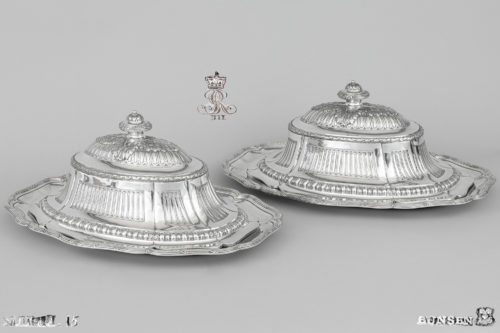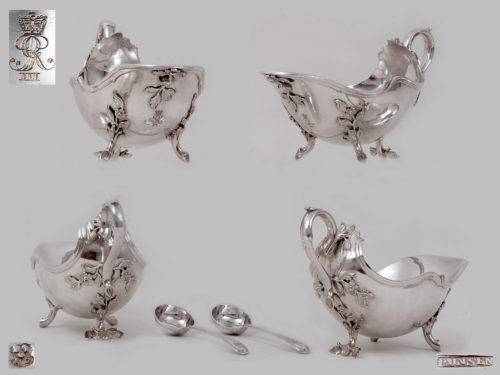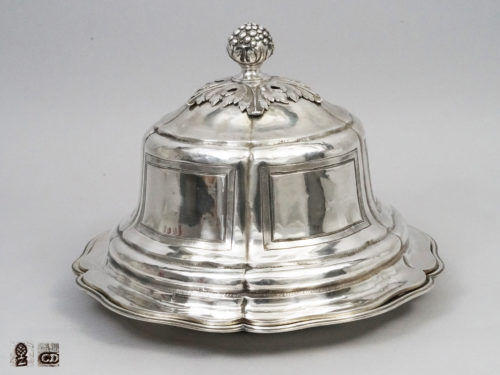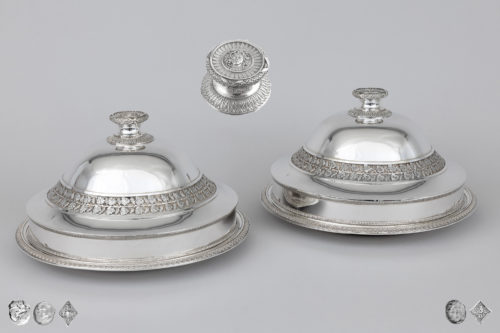Antique Silver
Invitation to a fascinating journey of discovery
Antique historical silver captivates collectors and enthusiasts alike with its unparalleled beauty, exquisite craftsmanship, and deep historical significance. The noble provenance and excellent preservation of these centuries-old objects emphasise their historical significance.
Each piece of silver, whether it be a delicate Renaissance Spoon from Bremen or a Pair of ornate Baroque Hannoverian candlesticks, tells a unique story of its time, reflecting the artistic, cultural, and social milieu in which it was created.
This fascination with antique silver is not just about owning or showcasing beautiful objects; it is about embarking on a journey of discovery that spans centuries.
Antique silver serves as a tangible link to the past. Each piece provides an insight into the social and cultural context of its creation. Lidded tankards, goblets and drinking vessels reveal much about the drinking habits and social etiquette of their time of origin. At the same time, antique silver can still be integrated into everyday life today, especially for special occasions – it lends an unrivalled lustre to elegant dinners and celebrations.
In this newsletter, we present a number of objects and offer detailed descriptions of outstanding pieces from our collection.
Historic large vessels of table culture
A pair of dish covers and serving plates from the services of King george iii of Hanover
Hanover 1794 and 1820
Master of the dish covers:
Frantz Peter Bun(d)sen, born 1725, sworn in 1754, court goldsmith from 1770, died 1795
Master of the serving plates:
Franz Anton Hans Nübell became a goldsmith, citizen of Hanover and court jeweller in 1819
Provenance: King George III of Great Britain and Ireland, Elector and King of Hanover (1760-1820)
Auction: Sotheby’s Tableware, Marienburg Castle, Hanover, October 2005, lots 1192-1194.
The pieces are oval in shape, the dish covers are decorated with banded cane rims, while the lids feature fluting beneath a laurel wreath band. The finial is decorated with acanthus leaf clasps, all pieces are engraved with the monogram of George III, King of Great Britain and Ireland and Elector and later King of Hanover, embossed on plates and covers.
King George Iii silver service
In 1771, the king authorised the project on the condition that design drawings be produced first. Two years later, Bundsen was no longer considered for the project. Although the reason for this is not known for certain, his designs probably did not meet with the king’s approval. Bundsen was certainly capable of carrying out such a large commission, as he was later asked to deliver a substantial part based on Augustus’ designs.
As Bundsen was no longer in the running, the chamberlain of Hanover looked further afield and invited the Wurth family of silversmiths in Vienna and Luigi Valadier in Rome to present their designs. Ultimately, however, these failed. After a break of four years, the commission was awarded to Robert-Joseph Auguste. It is possible that George III was familiar with the work of the Parisian silversmith from his friendship with Simon I Earl Harcourt (1714-1777), who was an enthusiastic patron of the arts. Indeed, Harcourt’s wine coolers by Auguste are clearly the inspiration for a pair in the Hanover Service.
Two pairs of silver sauce baots form the house of hanover, each with a serving ladle
Pair of sauce boats: Hanover 1766
Pair of sauce boats: Hanover 1779
Master: Franz Peter Bun(d)sen (ca. 1725-1795)
City mark: Cloverleaf with the number ‘15’ for Hanover
Dates: D [for 1766; see Scheffler, p. 714 and no. 1381] and E
Engraving: Monogram of George III.
Provenance: Royal House of Hanover – House of the Guelphs.
These two pairs of marvellous rococo sauce boats were part of a royal commission. The sauce boats have the shape of a ship and very elegant, wavy rims. The body stands on three moulded feet, shaped like branches. These are very realistically executed and moulded flowers are attached to the connection between the foot and the body. A moulded shell, very vividly worked, forms the rear of the sauce boat. The moulded, ear-shaped handle was placed on the back. The front also serves as a spout and is beautifully decorated with moulded foliage. The monogram ‘GR/III’ under a crown is engraved on the lower side of the bow; this corresponds to the monogram of George III. William Frederick (1738-1820), King of Great Britain and Ireland and Elector of Brunswick-Lüneburg. Both pairs come together with their serving ladle, which has a ‘fiddle and thread’ decoration. All pieces are labelled with the monogram of George III.
Royal silver entree dish and cover from the perm service of empress catherine the great of russia
Augsburg 1779-81
Master: Christian Drentwett II
Provenance: Ordered by Catherine the Great, Empress of Russia (reigned 1762-1796) for use in the Governor’s Palace in Perm. Recalled to the Winter Palace in St. Petersburg by her successor Paul I, Emperor of Russia (r. 1796-1801).
The cover has a smooth shape over a fitted ground plan. Flaring in the lower area.
The dish with moulded rim, the lid decorated with acanthus and leafy berry tips, the underside of the dish and outer rim of the lid punched, the dish and lid bear the number ‘2’, the dish further engraved ‘?: p:2’
Catherine the great and the silver government service
Tsarina Catherine II of Russia (1729-1796), known as Catherine the Great, had been organising a new Russian Empire since 1775. Many governorates were now to be represented by governors. New governors-general were appointed for these new administrative and political structures. When Catherine the Great travelled to these new provinces, she stayed in the residences of the respective governor, who was responsible for the luxurious reception and stay befitting a tsarina and had to be furnished with silver and vermeil tableware. Catherine’s commissions for such sumptuous silver services not only provided her with the necessary courtly luxury, but were also representative signs of her power and importance. They also formed a kind of treasure that she could have melted down if necessary.
Twenty-two dinner services were ordered for the new seats of the regional governments that Her Imperial Majesty established in Russia.
Five services were commissioned from Russian, London and Augsburg silversmiths. Christian Drentwett received the commission for the services in Perm (1779-1781) and Kharkov in the 1780s. The services all bear the same Cyrillic inventory mark, here ‘??’ for Perm.
The Splendour of the ‘époque impériale’
Two dish covers with serving dishes from Odiot and Biennais
Two covers: Paris 1798-1809
Two dishes: Paris 1798-1809
Master of the covers: Jean Baptiste Claude Odiot
Master of the dishes: Martin-Guillaume Biennais
The covers made by Jean Baptiste Claude Odiot, stands on a smooth base, which is finished at the top and bottom with a tongue frieze. A band of vine leaves and grapes is attached to the centre of the bonnet, which curves over the rim.
The skilfully designed knob begins with a surrounding frieze of tongues, above which the knob tapers inwards. The pommel ends as a round plate, which is decorated on the outside with a frieze of flowers and ribbons. In the centre is a woman’s head framed with foliage and grapes. Owner’s medallion on the lower edge of the inside.
The two dishes, masterfully crafted by Martin-Guillaume Biennais, bear a palmette frieze on the outer edge and deepen inwards in steps.
The coat of arms of the Balguerie family is applied to the outer edge of the top.
Discover the fascinating world of antique silver
Immerse yourself in the craftsmanship of past centuries, learn exciting stories about outstanding silver objects and appreciate the timeless beauty of the finest craftsmanship.
The Helga Matzke European Silver team is passionate about sharing its love of antique silver and invites you to discover our collection at the upcoming MUNICH HIGHLIGHTS between 17-20 October 2024 at the Residenz in Munich or online at www.helga-matzke.de.
Let yourself be enchanted by the magic of antique silver! Celebrate the rich heritage of European silversmithing with us and experience a visual adventure.
Your team Helga Matzke







